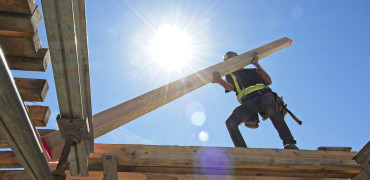I’m not a fan of targets. I never have been.
I understand why targets are set by government and organisations, because they give everyone something to strive for.
However, when a target is missed (and they regularly are) it brings disappointment. A lot of disappointment.
It also gives the press and any opposition parties all of the ammunition they need to criticise and say you’ve failed.
I’m afraid this seems to be the pattern of government over many years. Make a big headline grabbing announcement. Declare a big target that government confidently claims they are going to meet, often within a very ambitious timeframe. Miss the target.
The attack process then kicks in from opposition parties for missing the target and government then has to go on the defensive and search for excuses to get themselves out of a difficult situation that they themselves set.
It is ironic that politicians want big targets to get the press excited, but then get attacked by that very same press when they don’t meet those targets. Maybe in this day and age in the battle for news coverage, less ambitious, more achievable targets, just aren't exciting enough.
Local Authority house building completely collapsed since Margaret Thatcher came into power
Arbitary targets
We’ve seen this with house building targets for nearly 30 years. I’ve lost count of the number of times I’ve heard governments of all colours set a target of building 300,000 per year every year.
Liz Truss went even further and decided to pluck a figure of 500,000 homes out of the air in October 2023 based on no strategy or road map. Just another headline grabber!
To put this in context, the last time any government built 300,000 homes in a single year was Harold Wilson’s government in 1969/70. It is worth noting that in that year over 150,000 of the new homes built were by the private sector with the other 150,000 homes being built by local authorities. The public sector was building!
The truth is that the number of homes built by the private sector since 1969/70 is rarely over 150,000 homes per year (yes there have been a few peaks and troughs around this figure because housing is a boom and bust industry) but generally the private sector rarely builds over 150,000 homes per year.
Unfortunately, Local Authority house building has completely collapsed since Margaret Thatcher came into power. In a one-year period between 2022 and 2023 only 9,500 social homes were built by housing associations (HA) and local authorities (LA). A massive drop compared to the park of 150,000 builds per year.
The total number of new build home completions in 2023 (by the private sector, HA and LA combined) stood at only 158,190. So, how on earth are we going to get to 300,000 new homes per year? We can’t just magic them out of thin air.
The current government has committed to build 1.5 million new homes over the course of this parliament, stimulated primarily by changes to the planning system and planning reform.
I’m afraid this target is for the birds! It just isn’t going to happen. I’m not being pessimistic. I’m being realistic.
Set up to fail
So, why won’t we meet this target? Radical planning reforms just won’t come in fast enough. They will take years to come into force. Even if they do, we don’t have a big enough skilled labour force to be able to deliver 300,000 homes per year.
We’d need a hugely successful and fast-tracked UK apprenticeship push combined with encouraging overseas labour to come back to the UK to prop up the massive skills shortage the construction industry has at the moment.
UK Supply chains would need confidence in the housebuilding market to ramp up the supply of materials and products to give the house-builders they products and materials they’d need to actually construct 300,000 homes per year.
And from a financial perspective the banks may need to come up with more competitive, longer-term, more affordable mortgage deals, so people can actually afford to buy the home when they are built.
The economic market is in a poor state at the moment due to the cost of living crisis and increased mortgage rates. If we think that all of these issues are going to be addressed and fully resolved at a fast pace to meet the incredibly ambitious target of 300,000 homes per year, every year for the next 5 years is again for the birds!
I’m sorry, but there isn’t a radical and achievable roadmap for us to get there in that time.
A miracle in social housing
If I was to speculate for a moment. And this is massive speculation. Let’s say all of these things did happen. That planning reform, a massive skills and apprenticeship push, radical legislation, support from government, a confident and efficient supply chain system combined with a competitive and affordable mortgage market managed to boost the private house building sector to 200,000 homes per year.
That would be hugely ambitious in it itself. It would be an incredible achievement. To put this in context, the private housebuilding sector has only reached this level in a handful of years since 1946 and not at all since the 1960s!
To then build another 100,000 homes per year on top of 200,000 per year from the private sector, would require the biggest revolution in social house building, by government, Local Authorities and Housing Associations in over 50 years.
It would require a 10-fold increase from 9,500 homes per year to 100,000 homes per year. This would be a revelation. Possibly even a miracle!
A long-term commitment for the Public sector to step in and build our genuinely affordable housing requirement by building 100,000 ecologically sustainable homes per year would provide a consistent supply of homes for the country.
It would boost the home building industry. It would create tens of thousands of jobs. It would make an enormous contribution to economic growth, which we are severely lacking in at the moment. But, more importantly, it would transform the lives of many families in need of a safe, secure, stable and affordable home.
It needs to be achievable
Unfortunately, I doubt whether local authorities and housing associations have the internal skills, council housing departments, have the knowledge, resource or capacity to deliver 100,000 homes per year. They certainly don’t have the money.
An achievable target needs an intelligent strategy and government policies have to be perfectly crafted around that strategy.
At the moment I have absolutely no idea where the target of building 300,000 new build homes per year comes from. I’m sorry, but I certainly haven’t seen a radical strategy or radical policy changes, for us to get there. Maybe they are on their way. But, we need to get a move on.
All of this has an enormous impact on the green homes agenda and our journey to a net zero carbon future. We know that home heating accounts for 18% of the UK greenhouse gas emissions (25% in all buildings) and we know we need to reduce our dependancy on burning fossil fuels, instead moving home heating to a renewable, clean, green, electrified energy solution.
The government should 100% be congratulated for putting heat pumps at the forefront of the agenda when it comes to renewable home heating. It has introduced its ‘Low-Carbon Heat Scheme’ and their amazing ‘Boiler Upgrade Scheme’ has been a big step in the right direction and stimulated the industry. But, again, an ambitious target has been set without a clear path of how to achieve it.
A long way to go
In October 2021 the UK government made the following announcement in its ‘Heat and Buildings Strategy’: "A UK market with the capacity and capability to deploy at least 600,000 hydronic heat pump systems per year by 2028 can keep us on track to get to Net Zero and set us up for further growth if required."
600,000 heat pump installations per year by 2028? That’s is a massive number compared to where we are now.
The progression in air source heat pump installations in the UK has been truly amazing over the last few years. Public awareness about the technology is growing and the number of home installations continues to rise, but they are miles away from the 2028 government target.
The number of certified UK heat pump installations in 2019 was 24,076. In 2020 there were 28,878. In 2021 33,262. In 2022 49,417 and in 2023 58,211. To put our domestic heat pump installation in context with our European neighbours in 2022 France was one of the biggest installers with 622,000 units being installed in a single year, followed by Italy (514,000), Germany (276,000), Sweden (215,000), Poland (208,000) and Spain (185,000). Remember the 2022 UK figure (49,417).
(I don’t yet have the confirmed numbers for 2024 , but there is a chance that installations may not have risen at the same or a similar percentage rate as the rate over last 5 years because of European economies struggling, the cost of living crisis biting harder and general economic uncertainty combined with the disappointing backlash in green policies. European sales may have actually gone backwards).
A strong government
So, how on earth are we going to go from 58,211 certified heat pump installations in 2023 to 600,000 per year by 2028? This simply cannot be left to the free market. Government has to be strong, it has to lead and it has to legislate for it.
The previous government made a commitment for all gas and oil fired boilers to be banned from all new build housing by 2025. It then backtracked on this. I can only assume that this was because of pressure from powerful parts of the house building industry and from elements of the gas boiler industry that are resistant to change.
There are very powerful companies and organisations that have been lobbying Number 10 hard to slow the transition to net zero when it comes to UK housing.
But, this is no time for governments to waiver. It is certainly no time to back track or be resistant to change.
The ambitious target for the number of new build homes also doesn’t seem to be strategically connected to the target for Heat Pump installations.
There seems to be a lack of pace and clarity. Many consultations by the previous government haven’t been initiated. Levies between gas and electricity haven’t been rebalanced. And decisions due way back in 2022 to end gas-grid connections to new housing estates have not been made.
The retrofit challenge
Even if we built 300,000 new build homes per year on new housing estates and fitted them all with clean, green renewable heating technology, that still leaves a requirement of 300,000 air source heat pump installations in EXISTING UK homes to meet the massive 600,000 installation target.
Of course, when it comes to retrofitting renewable heating technologies into existing housing stock, we need to do everything we can to support existing owner/occupiers to make that change. They will need incentives to do that (continuation of the Boiler upgrade Scheme for example) as it will prove difficult to legislate for it.
But, when it comes to new build housing, we cannot expect consumers to retrofit a gas boiler with a clean, green air source heat pump after they’ve bought a new build house post-2025. Surely, it should be up to the house builders to fit an air source heat pump at construction stage if we are to embrace renewable heating from today.
Banning gas boilers
There are rumours that gas boilers will be banned from all NEW BUILD homes from 2027 in the government’s long over-due ‘Future Homes Standard’ which is due to be announced sometime this year.
The Future Homes Standard for new build housing will be the benchmark for the home-building industry for many years to come. It has to be radical if we have any chance of meeting our Net Zero Carbon targets. Otherwise it will be another target missed.
The government must be brave and bold to protect homeowners. It also needs to address the unfair difference in levies it makes between gas and electricity.
The wholesale price of electricity is capped at 24.5p per kWh where’s gas is capped at 6.24p per kWh, so we need to make electricity cheaper. The government levy on electricity averages at £131 per year, but it is only £34 per year for gas. This imbalance must be sorted out too. It has to be a level playing field between gas and electricity at least.
Energy security
A strong, green homes agenda will give us energy security, it will make our new homes warmer, cosier and cheaper to run and it will significantly reduce our UK carbon emissions. It will reduce energy bills for consumers.
We know that air source heat pump technology has been proven to work and be affordable across Europe. It is time for the UK home building industry to step up, embrace ecological change and do what is right for UK homebuyers.
We deserve better quality and greener homes that are cheaper for consumers to run for the price we are paying for houses these days.
In February 2023 the CBRE wrote: “The Future Homes Standard - homes built from 2025 will produce 75-80% less carbon emissions than homes built under the current building regulations.”
The ‘Future Home Standard’ is the greatest opportunity for positive change in the UK housing building industry for over a generation. It can boost our economy, job creation and our net GDP.
But, it also needs a strong strategy, bold policies, the necessary investment, an achievable road map and genuinely achievable targets for the industry to deliver the new standard. Let’s hope it isn’t an opportunity missed.
(As a footnote it is worth noting that in the last few weeks the government has stepped back from a complete ban on ALL gas boilers in all ALL UK housing (both existing homes and new build).
The previous Conservative government had laid plans to phase out gas heating for all homes by banning the sale of new gas boilers by 2035, so people replacing their gas boilers in any home after that date would instead have to buy a heat pump or other environmentally friendly way of heating homes.
But let’s hope a ban on gas boilers in all NEW BUILD HOMES comes into force soon.
Installing a new air source heat pump into a new build home is much cheaper at construction stage than retrofitting one at a later date to replace a gas boiler installation).
George Clarke is a TV presenter, architect, writer and Ecodan Ambassador




